Dean &
Ginny's excellent adventures... Main
Adventure Page
Grand
Voyage--2012:
<<
Part 1 <<
Part 2 <<
Part 3 <<
Part 4 <<
Part 5 <<
Part 6 <<
Part 7 <<
Part 8
<<
Part 9 <<
Part 10 <<
Part 11 <<
Part 12 <<
Part 13 Part
14 Part
15 >>
Part 16 >>
Part 17 >>
Part 18 >>
Part 19 >>
Part
20 >>
Part 21 >>
Part 22 >>
Part 23 >>
Part 24 >>
Part 25 >>
|
|

|

|
|
 A
rainstorm over one of the Indonesian islands is colored a dark
golden hue by the setting sun. In these relatively shallow waters we saw
several large dolphin pods swimming with us. A
rainstorm over one of the Indonesian islands is colored a dark
golden hue by the setting sun. In these relatively shallow waters we saw
several large dolphin pods swimming with us.
As we sailed into Indonesian waters and close to
some of the islands, many of our room stewards, wait staff, and
other lower echelon crew members huddled in leeward spaces on the upper
decks with their cell phones talking with family members. Holland
America has a big training facility in Java and hires many of their staff
members from here. The general economy is quite poor, so there is never
a shortage of workers.
<< We saw
a number of these beautiful butterflies in Australia, but never
could get one to alight long enough for a photo. I'm afraid that
this one trapped in the mid-pool area will not make it even if it
lives long enough to escape. It'll be on a different continent.
|
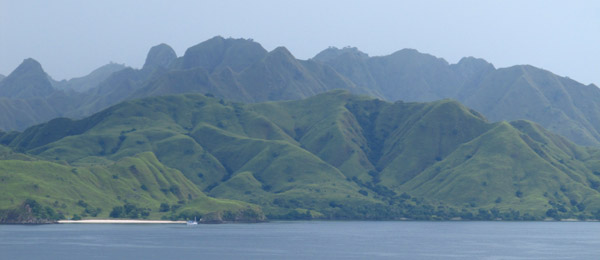
Komodo and the surrounding islands are a gorgeous green. Of
course, this is the wet season, so at some other time of year, they'd be
a different hue.
 
We had to pay for a ship-sponsored tour in order to get onto the island.
The ship excursions group had pre-hired all the available guides.
|
|


Our group of 25 people received the initial briefing before leaving the
beach area with our guide and a guard who were armed only with forked
sticks.


 |
 |

|
|
Our guide explained about how the palms here
bloom once and then die. The pigeons made a lot of noise as they
feasted on the fruit atop the trees. Then he talked to us about a cycad with
fruit that puts out a sticky liquid.

Then we came to a dragon sleeping in the path...


But not for long with all the ruckus around him.
 
Both the guide and the guard at the back end of the group used
their sticks to guide the dragon away from us.
Then a little farther down the path we saw a
young dragon climb down from a tree. The young learn to climb
trees, otherwise they'd be eaten by older dragons, apparently even
their own parents. The dragons produce venom and they also have
nasty bacteria in their saliva. The usual mode of
predation is to bite their prey once and then follow it while waiting for it to die, but they can run as
fast as 12 mph and they can swim, too. Also, check out those
claws!
|
|

|
We came to several dragons in an open area of the
forest.


We saw some more beautiful wildlife as well.
Isn't this snail fantastic looking??
 
After our mile-long walk and several dragons later, we ended up back at
the beach. We avoided the market with the very aggressive vendors
selling t-shirts, pearl jewelry, and carved wooden
dragons. We walked the beach instead.
|
|
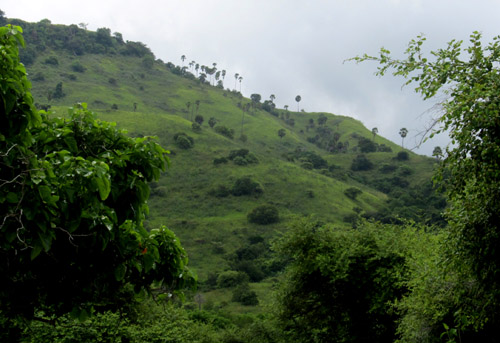

Looking back up the slopes, the landscape looks exotic and inviting. The
deer, prime dragon prey, browsed casually along the shore, but later as we left,
we could
see them gather in large groups on the open beaches--probably a
defensive strategy to have more warning time of a dragon attack. They'd
recently shed their antlers for the season and so have only their speed
to escape.


Beautiful shells, pieces of coral, and driftwood mingle with the plastic
trash on the beach.
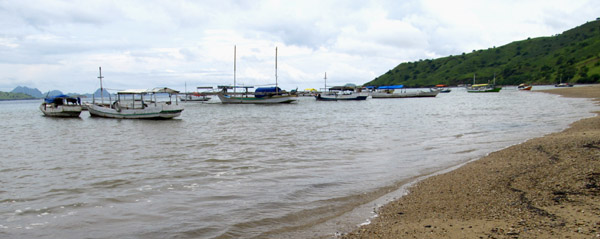
|
|

The dinghies here can be just a piece of Styrofoam propelled with a
stick.
|

We continued our beach walk while waiting
for the tender line to get shorter.
|
|
 
As our tender tied up to the ship to unload, some aggressive locals
were still trying to sell us stuff. Their boats are primitive at
best.


After we were aboard, we could see these vendors
still working the crowds. After we were all aboard, the whole market
area on shore was disassembled and loaded, blue tarps and all, into the boats we saw off
the beach. There are no main roads back to the village, so everyone
travels via boat. Some boats used for fishing have extensive
outriggers--not sure whether the outriggers are used in the fishing
process or whether they are for stability.
~ ~ ~
|
|
The next day was another tender
port at Lembar on the island of Lombok. We planned to go diving with
our group.


We were greeted by musicians and dancers as our tender came into the
dock. We walked along the red carpet out to the minibus, which took
the eleven us out to the dive shop. It was an educational
45-minute drive through various neighborhoods, communities, and rice paddies. People
are very poor, but the schools looked well cared for and we also saw
quite a few satellite dishes for TV.
|
|
|

|

|
|

Our group went out on two separate boats, neither
of which were set up specifically for diving. It was about a 30 minute ride out
to the reef from the beach. There was a lot of garbage in the
water and we had to stop once for a plastic bag that had become
entangled in the prop.
The equipment was old and it took a while to get
everyone suited up and in the water.
<<
The divemaster (on the left) spoke some English, but the other two
crew did not.
After all that, though, once we were in the water,
it was an interesting dive along a reef wall.
|
|



A sea cucumber, but the black, frilly
tentacles as seen in the upper left of the photo indicate that
it was feeding.
|



A loggerhead turtle rests near the bottom.
|
|
|

The most exciting find was a Cuttlefish. It's a squid relative that
we'd learned about on PBS, but had never seen one in the wild before. This
one was an adult about a foot long. The curved eye
is the giveaway because they are so clever at disguising themselves as the
surroundings. I've labeled the eye so that the down arrow is just
above the top of the fish--follow the arrow down to see the eye halfway
down the fish. The second photo makes it easier to see because it's backed up over the brain
coral. The third photo is a more frontal view of the Cuttlefish with its
tentacles disguised to look like a different coral. There was a lot of activity
around it with two cameras and five divers, but it held its
ground--certain that it was invisible. Love the skirt around the
bottom making it look like a hovercraft in a way.


|
|


We think these are eggs of some kind, but maybe they're something
altogether different. The animal on the right actively waved its
tentacles and we think it's a feather starfish, but don't know for
sure.
 
This anemone seemed to glow from the inside: it served as shelter
for black & white clown fish and a small green crab.
|
|
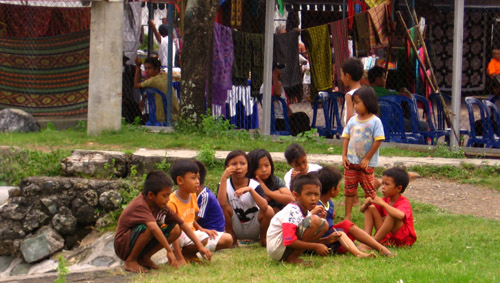

Back at the dock, kids gathered behind the
market space, which was probably manned by their parents.

A couple of small villages as seen from the tender.

|
|


We saw a lot of these bamboo fishing houses.
Apparently, when the fish are running, people let down the
nets.
Now we're off for four days of sailing northward
to get to Hong Kong. On the way we passed over the equator
and the ship held a King Neptune ceremony for the crew who had not
sailed across it before--the pollywogs. Last time we crossed it, it was the
middle of the night--this time, it was mid morning.
|
|

Then they had to kiss the fish and were slimed with a concoction
that looked like cake batter.
|
The pollywogs were hauled in front of the captain
and ship's officers to plead their case while the charges against
them were read. The two in charge of the laundry services
were accused of shrinking the clothing and then blaming the good
food. The piano player was accused of being too darn cheerful and
knowing too many songs.

|
|

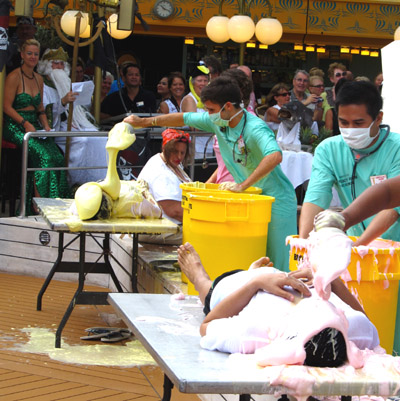
King Neptune and his court oversaw the ceremony. Barbara our
travel guide played a disheveled cleaning lady.


Dean kissed the fish after the ceremonies were over. Later
we received our own certificates to add to the many others on this
voyage. Dean adorned his with shells and corals from
the Komodo beach.

Now on to Hong Kong!
Dean's
Log: Days 59 - 65
|
|


 A
rainstorm over one of the Indonesian islands is colored a dark
golden hue by the setting sun. In these relatively shallow waters we saw
several large dolphin pods swimming with us.
A
rainstorm over one of the Indonesian islands is colored a dark
golden hue by the setting sun. In these relatively shallow waters we saw
several large dolphin pods swimming with us.




























































